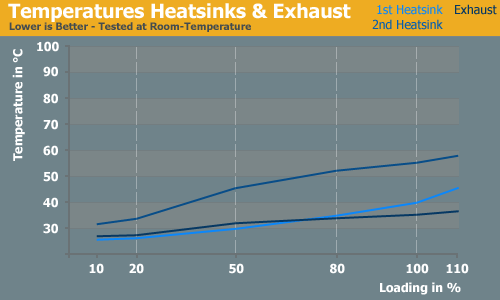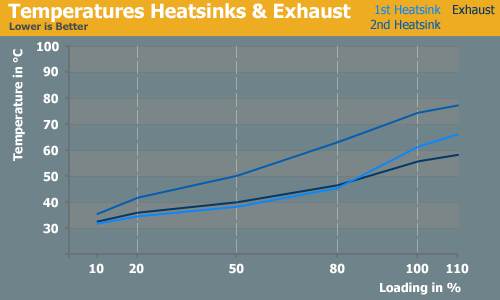400-450W PSU Roundup
by Christoph Katzer on November 6, 2007 4:00 AM EST- Posted in
- Cases/Cooling/PSUs
Thermaltake PFC, Temperature, Fan Speed, and Acoustics


Heatsink temperatures aren't as hot as what we saw with the Corsair and Antec units, but they still reach nearly 80°C during stress testing in our heat chamber. The heatsinks do seem to be able to dissipate a bit more heat into the airflow -- or more likely the large fan and increased airflow are simply doing a reasonable job of removing heat.


At normal room temperature, the fan turns at its minimum speed of 1100 RPM off to a load of around 220W. Maximum fan speed occurs at loads of roughly 80% and above. Thermaltake is definitely erring on the side of fan speed and airflow rather than keeping noise levels low, as the heat chamber reaches maximum fan speed at the 50% load. With a larger fan and relatively high RPMs, it's not too surprising that this becomes one of the noisier power supplies, particularly in the 500W and lower range.



Heatsink temperatures aren't as hot as what we saw with the Corsair and Antec units, but they still reach nearly 80°C during stress testing in our heat chamber. The heatsinks do seem to be able to dissipate a bit more heat into the airflow -- or more likely the large fan and increased airflow are simply doing a reasonable job of removing heat.


At normal room temperature, the fan turns at its minimum speed of 1100 RPM off to a load of around 220W. Maximum fan speed occurs at loads of roughly 80% and above. Thermaltake is definitely erring on the side of fan speed and airflow rather than keeping noise levels low, as the heat chamber reaches maximum fan speed at the 50% load. With a larger fan and relatively high RPMs, it's not too surprising that this becomes one of the noisier power supplies, particularly in the 500W and lower range.











37 Comments
View All Comments
zeroidea - Wednesday, November 7, 2007 - link
The Antec PS featured in this article is currently on sale at staples.com for $30.http://www.staples.com/webapp/wcs/stores/servlet/S...">Link
SilthDraeth - Wednesday, November 7, 2007 - link
I know it falls outside of the 450Watt max, but it is still below the 500 watt barrier. I just bought the psu for a midrange system I built my mom, I know it works well, but I don't have the ability to test everything.One can wish right?
Noya - Tuesday, November 6, 2007 - link
If you look around (buy.com), the Corsair 450vx can be had from $51-61 pretty regularly, and at that price it's untouchable. I must say I've had one for about two months and haven't had any problems with it.smthmlk - Tuesday, November 6, 2007 - link
Can we have a full list of caps in each unit? Noting the primaries is nice, but what about the others? Thanks.Talcite - Tuesday, November 6, 2007 - link
Thanks for finally putting up O-scope readings, it's quite nice to see them. One thing I'm concerned about though is the lack of explication or analysis.For example, is the entire o-scope range 200mV in the 12v readings or is it one division? Also, there's a number of strange spikes in all the o-scope readings. I'm pretty familiar with the 450VX o-scope readings (mostly from other sites) and I haven't noticed any spikes of that nature in their readings. It probably isn't, but is the equipment faulty?
Thanks for putting the readings up anyways though, they're a nice addition.
Super Nade - Tuesday, November 6, 2007 - link
Those strange spikes are probe noise. If the probe is coupled incorrectly, you will see this artifact. This cold be due to any number of factors like EMI for instance. Following the ATX guideline on using 0.1 uF output coupling caps will minimize this to a great extent.MrOblivious - Tuesday, November 6, 2007 - link
You have to look at the sampling time on the readings to compare between sites. Different sampling times will make the traces appear a bit different.phaxmohdem - Tuesday, November 6, 2007 - link
I just recently built a rig for a buddy using a Thermaltake PurePower (or ToughPower.. can't remember) 480W Unit and it works like a champ powering a Core2 Quad Q6600 CPU, 2GB RAM, 2HDD's, two Optical Drives, 8600GT, TV Tuner and a few fans. (Wish I knew about the Corsair PSU when I spec'd that system out).But yeah, Unfortunately most people equate Watts to overall quality.... not unlike the MHz war of days gone by. Power supplies are one of the hardest components to convince people to spend extra on for some reason. FFS, electricity is kind of the basis of the whole dam computer!
Eventually it ends up as "Oh well. Go ahead and get that 600W $30 power supply and let me know how that goes for ya. I could use a good laugh, and don't say I didn't warn you."
strikeback03 - Tuesday, November 6, 2007 - link
Maybe Anandtech should go ahead and list the weight of each PSU. That has long been used as an estimate of quality.jonnyGURU - Tuesday, November 6, 2007 - link
Not any more. Topologies have changed to the point where you can have very light quality units and very heavy crap. Weight is NOT a factor.